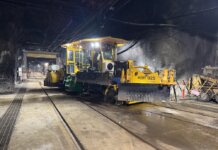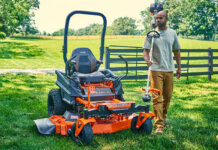
When Jim McKee started Alabama Guardrail in 1974, his Pinson company had one crew putting guardrails up on highways and other roads in Alabama.
“He was one of a handful of people doing that,” says Keith Dillard, McKee’s son-in-law and now president of Alabama Guardrail. “The guardrail industry as a whole at that time was usually constructed out of fence companies or construction companies. Most of the time, companies didn’t even have the word guardrail in it. He capitalized on Alabama Guardrail to set himself apart.”
As the company celebrates its 50th year, it has expanded to many different crews, still specializing in highway guardrails but adding highway median cables and overhead signs to the mix.
It’s also still a family business, with Keith Dillard at the helm and his son, Wes, serving as vice president.
Keith Dillard came to Alabama Guardrail when he married McKee’s oldest daughter in 1978. He went to work for Alabama Guardrail full-time in 1991.
“He was like a daddy to me,” Dillard says of McKee. “He had three girls, and I was the only guy. … I learned every aspect of the business, and that’s how I started.”
Wes Dillard started working for the company right after graduating from Hayden High School, though he had been around the company for years before that.
“I would come out in the summers and sort nuts and bolts and wash trucks and fill the Coke machine,” he recalls. “I just wanted to be involved. Pretty much my job description was, ‘Yes sir, I’ll do it.’ I just wanted to learn.”
In 2006, McKee retired and Keith Dillard bought Alabama Guardrail with the company’s corporate secretary. That partnership was dissolved in 2017, three years after Alabama Guardrail moved to Cleveland in Blount County, and Dillard became president.

Over the years, Alabama Guardrail has grown and added specialties, but its bread-and-butter has always been guardrails on Alabama roadways — which are more involved than one might think.
“What the general public sees going down the highway is a ribbon of steel guardrail,” says Keith Dillard. “But what they don’t realize is that the first 50 feet of that guardrail is a designed impact device engineered to control a vehicle to a stop. To the general public, it just looks like a guardrail.
“Guardrail is installed as an engineered system specifically designed for the location being placed, not just installed at random,” Dillard adds. “75% of the guardrail we install is for various ALDOT projects across the state.”
The same can be said about Alabama Guardrail’s overhead signs business, which Wes Dillard has had a big hand in growing.
“It’s a specialty field, and there’s a lot of detail that goes into those projects,” Keith Dillard says. “Wes came in at a time when we had quite a bit of sign work going on, and he grasped it really quick. He understands all the variables, and that has led us into bigger things.”
Chief among them? The massive renovation several years ago of Birmingham’s downtown interchange, where I-65 and I-20 converge.
“We did 32 overhead signs, and they’re the biggest overhead signs in the Southeast, as far as the square footage of the sign panels themselves,” Wes Dillard says. “The bigger the sign is, the more wind it can take.”
Like guardrails, there’s a lot more to overhead signage than meets the public’s eye.
“They are uniquely designed for each specific roadway, and there’s a lot of engineering that goes into them,” Wes Dillard says. “On the engineering side, how big the sign determines how big the footing is, how deep, how big around.”
And then there’s what happens above the ground.

“You have the footing aspect of it, and then you have the above ground,” Wes Dillard says. “A lot of things have to flow in order to pull off an overhead sign. If you get off a foot on the footing, then it’s not going to fit. It’s either going to be too long or too short. You have to be exact.”
Adding projects such as overhead signage and cables in medians aren’t the only changes Alabama Guardrail has seen. The industry itself is “ever-changing” because the way people travel continuously evolves, Keith Dillard says.
“It’s always changing due to the size of vehicles, the speed on roadways and the terrain,” he says. “The biggest movement that we’ve seen in the past four or five years is changing the standard of guardrail to install it in a different way and at a different height. That’s to offset that 20 years ago, the general public traveling in a car was in a four-door sedan, and now 90-plus-percent of it is SUVs, which are larger and taller. The guardrails were too low to fit vehicles on the road now.”
Looking back over 50 years, Keith Dillard says two things jump out at him as key memories.
“Barber Motorsports Park is one of them,” he says. “We supplied and installed every foot of the guardrail around that race track. Another one is the rocket up in Limestone County that is no longer there. But we have a photo that shows double-faced guardrail on I-65 with the rocket in the background. We take pride that we got to do that.”
There are points of pride like that all over the state.
“My wife gets tired of me saying, ‘We did this, we did that’ when we’re on the road,” Wes Dillard says with a laugh.
And they didn’t do it alone, Keith Dillard emphasizes.
“We have been fortunate and blessed to work with some great general contractors over the years,” he says. “We would not be where we’re at without the relationship that we’ve had with other general contractors and the AGC.”
Alabama Guardrail is carrying on the tradition and work ethic of Jim McKee.
“My father-in-law was a man of great integrity, and we’ve adopted that whole philosophy,” Keith Dillard says. “We’ve just been blessed to be able to take a small business that Jim poured his heart and soul into and take it to the next step.”
As Alabama Guardrail turns 50, there’s already a fourth generation working there – Wes Dillard’s oldest son, J.D., who is 20. And Wes Dillard is ready for the next half-century.
“The first 50 years, we feel like we have worked with righteousness and character and trying to do right,” he says. “The next 50 years, we would want to continue that. We strive to do what we say we’re going to do and do it the right way. … When you work hard and do your best to do things the right way, you get blessed for it, and we definitely have.”
Alec Harvey is executive editor of Business Alabama and Art Meripol is a freelance contributor. Both are based in Birmingham.
This article appears in the June 2024 issue of Business Alabama.



